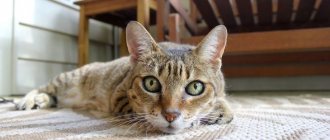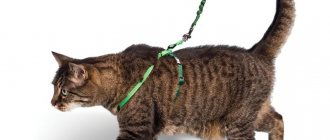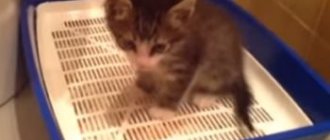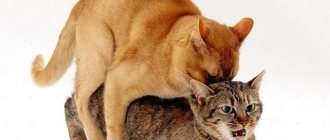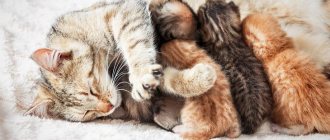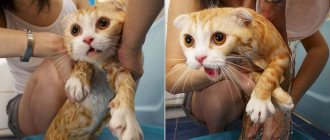The bringing together of two felines of the opposite sex is called mating. It is carried out to reproduce offspring from animals. However, before arranging mating, the owner must take into account many of the nuances of this event. First of all, you should wait for the cat and cat to mature both physically and sexually. Also, before mating a cat with a cat for the first time, it is necessary to create an appropriate environment for the animals and make sure that they are completely healthy. Veterinarians recommend breeding cats and female cats no earlier than one and a half years old.
Puberty and physical maturity of animals
Many inexperienced owners confuse these two concepts. As a result, they breed a cat with a cat too early, which provokes a difficult birth and the appearance of a weak litter. Mating of animals should occur only after they reach puberty. In cats and cats it occurs at different times.
In this case, the cat comes into heat much earlier than puberty. It usually begins at six months, and in some cases it may appear earlier. This physiological process does not mean that it is necessary to immediately take the cat to mating. Therefore, when a cat wants a cat for the first time, there is no need to immediately take her to mating. The pet’s body is not yet formed at this age, and therefore the cat will not be able to give birth to healthy offspring.
Her own life will also be at risk, since childbirth occurs normally only in fully developed animals. Therefore, you can contact your veterinarian for advice when your cat asks for a cat for the first time. This specialist will tell you best what to do in such a situation. He may prescribe special herbal drops for cats. They will calm the animal and relieve signs of estrus without side effects on the body.
Should you give your cat birth control?
This is a very important issue that requires separate consideration. Many cat owners consider such medications to be an alternative to sterilizing their animal, but this is not true: contraceptives cause irreparable harm to your pet! In particular, they can cause:
- the appearance of neoplasms in the uterus,
- the occurrence of ovarian cysts,
- hormonal imbalances.
In this case, pathologies of the reproductive system can occur only after a few years, when the cat is already elderly, and you will have to either decide on a risky operation or euthanize the animal. Therefore, if you do not want to endure regular heat and the cat’s behavior after mating, it is better to immediately sterilize your pet, which will not only save you from the hassle of organizing mating, but will also protect your cat from serious and dangerous diseases.
Join us in social networks:
Just yesterday the kitten was cute, docile, playful, but today his behavior has changed dramatically. The animal shows aggression, it is attracted by the street, the thirst for communication with its fellow tribesmen. This is how the readiness to procreate is manifested. What awaits kitten owners at this time and how to react correctly to the process of growing up of the pet?
Age for first mating
When thinking about how to mate a cat with a male cat for the first time, it is very important to remember that the best period for the first mating in cats is considered to be the time after three or four heats. As for males, they should be kept untied for up to one and a half to two years. Despite the recommendations for such a late mating in cats, they still need to be neutered much earlier - at seven or eight months. If you breed a cat with a very young cat, this can lead to a deterioration in its further development, as well as the appearance of dysfunctional offspring.
Non-standard cases
It happens that after giving birth a cat refuses her cubs and becomes aggressive towards them. In this case, the kittens are transplanted to another nursing mother cat, having previously rubbed them with her milk. If this is not possible, babies are fed artificially from a nipple or pipette, protecting them from the cold and changing the bedding.
Cow's milk and baby food are not close in composition to cat's milk. If possible, kittens are given a mixture of 2 tablespoons of concentrated milk, 2 tablespoons of boiled water and ¼ teaspoon of glucose. The temperature of food and water should be 38 degrees. If the kitten does not eat, moisten its face with food. The eyes are washed with tea leaves.
When giving kittens to a new family, owners are informed about the habits of the cubs, as well as about the vaccinations and treatments performed.
Best articles: How many vertebrae are there in a cat's tail?
Nowadays, cats of some breeds are popular. Let us dwell on the issues of their reproduction.
Signs of puberty
If the owner is not sure of the exact age of his pet, it is necessary to determine puberty by external signs and behavior. Readiness for mating can be manifested by the following changes:
- Cats become more aggressive for no apparent reason. While cats, on the contrary, are very affectionate, gentle and tame.
- Cats develop the habit of marking the surrounding territory. These can be the most inappropriate places, both in the apartment and on the street. At the same time, the urine acquires a strong and pungent odor.
- Animals are constantly active and are rarely in a relaxed state. This is especially evident when the cat asks for the cat for the first time.
- Cats make unusual sounds, begin to scream and howl. When in motion, they do not stand straight, but arch their backs and strongly raise their tail upwards.
- Cats constantly roll on the floor, trample their paws and rub their faces against surrounding objects.
Mating rules
By the time the animals have reached the optimal age, their owners already need to know everything about how cats mate, have a suitable partner in mind (or better yet, several) and stipulate all the conditions for the upcoming event.
Conditions for keeping males and female cats before mating
It is very important that by the time of mating both partners have been vaccinated against the most dangerous infectious diseases, in particular against rabies, panleukopenia (feline distemper), calicivirus, rhinotracheitis, and also, if possible, against chlamydia and lichen.
In addition, animals must undergo deworming (taking anti-worm medications).
Vaccinations for cats are usually done once a year, deworming is usually done once a quarter, but ten days before vaccination it is necessary to carry out this procedure, regardless of how long ago you last performed this procedure.
Important! All of these procedures must be carried out in advance, since at least two weeks before mating and before the end of lactation, cats cannot be vaccinated or wormed, as this may have a negative impact on the offspring!
If you plan to use a cat for breeding, you need to be especially careful about your pet's diet. An obese or, conversely, skinny animal is not able to produce healthy and full-fledged offspring. In addition, an overfed female becomes pregnant very difficult and gives birth even more difficult.
It is important to regularly see a veterinarian, who will assess the cat’s condition and give the necessary recommendations for adjusting the diet.
As you know, a cat does not need special pickles; it is important that the food is balanced. The selected diet should not be changed dramatically before mating, however, several months before the upcoming event, it is worth adding multivitamins and mineral supplements, in particular calcium, to the usual diet.
Important! Long-haired cats have a greater need for calcium during pregnancy than short-haired cats!
Also, before mating, both the cat and the tom should be protected as much as possible from all kinds of stress and emotional upheaval, as well as from hypothermia and drafts.
How to choose a partner?
Recently, the World Cat Federation has seriously tightened the rules for breeders who breed cats.
This happens because ignorance of basic things and ignoring established rules increasingly leads not only to the “clogging” of the breed, but also to the frequent birth of kittens with serious hereditary anomalies, which, unfortunately, often do not appear immediately and lead to serious tragedies (namely This is how one can characterize the situation when a beloved animal that has become a member of the family dies in terrible agony in the arms of its owners).
So, breeders of purebred cats are strongly advised not to select partners from advertisements, especially focusing on the cost of mating. Ideally, you should address this issue to a professional club, where specialists will take care of the process.
If you do do this yourself, you should know the following rules and restrictions:
1) Avoidance of inbreeding, that is, closely related mating. Carefully study the pedigrees of both animals and make sure that they are not at least first-generation relatives (parents and children, brothers and sisters). Common ancestors in the second generation are also undesirable; in subsequent generations they are acceptable, however, the fewer coincidences in the pedigrees, the stronger the kittens’ immunity.
Did you know? Kinship mating is not as scary as is commonly believed, since almost all breeding work is based on it: in order to consolidate at the genetic level the traits that are most successful in terms of breeding a new breed, close relatives are repeatedly paired with each other. However, such work should be done by professionals; at the amateur level, incest should still be avoided.
2) Mating should take place according to the “best with the best” principle. Learn to evaluate animals of the appropriate breed based on external characteristics and calculate what kind of kittens to expect from the appropriate mating. If you don’t have such experience, you can pick up a cat at the exhibition, consulting with the experts present at it or making sure of the high rating that your potential chosen one received. It is also useful to hear an expert’s opinion about the cat in order to decide which qualities in the offspring you need to strengthen, and which you don’t need to worry about.
3) Knowledge of the basic rules of genetics allows you to almost accurately determine the color of future kittens, knowing the pedigree of the parents. If, for example, you are the owner of an Abyssinian cat of the rare fawn color, and you want to have kittens of the same color in your litter, it is better for you to select a fawn cat, since the gene responsible for this color is recessive and will be suppressed by the gene of a different color.
There are cat breeds within which it is strictly not recommended to mix certain colors (for example, you cannot breed a solid-colored British cat with a marbled cat and vice versa, since such mating results in kittens with a blurred, low-quality pattern).
As with related matings, only an experienced breeder who clearly knows what he wants and is ready to get intermediate options for subsequent work can afford to “play with colors.”
4) Obtaining healthy offspring involves choosing a cat with a blood type suitable for a given cat, otherwise there is a high risk of kittens appearing with a disease that is practically incompatible with life, called hemolysis.
Did you know? Cats, unlike people, have not four, but only three blood types.
-
A, A/b and B. Cats with type B blood should not be bred to cats with type A blood, although it is interesting that reverse matings are considered safe.
A cat's blood test is not as simple and common as a human test. However, if as a result of mating you are faced with the fact that the kitten has blood in its urine in the first days of life, most likely you are faced with incompatibility of the couple in terms of blood type.
In this situation, it is better to choose another cat for the next mating.
5) As a general rule, mating should be done within the breed, but there are certain exceptions. For example, the American Cat Fanciers' Association (CFA) officially allows interbreeding of Orientals with Siamese, and in the pedigree of the British you can sometimes find ancestors of the Persian line, and this is not considered a marriage.
Did you know? Interbreeding, as well as related ones, are widely used in breeding. For example, it has been noted that adding a little aboriginal (local) blood to a valuable breed significantly enhances the immunity and health of subsequent generations. This is understandable, because local cats are bred by evolutionary means by nature itself, in which, as is known, the strongest wins, while artificial selection, as a rule, on the contrary, relies on random mutations (this is how fold-eared and tailless cats were bred, and also rex
—
cats with characteristic astrakhan fur).
Preparing for mating
In addition to pre-made vaccinations, both animals must be examined by a veterinarian before mating to make sure that they are completely healthy.
Before bringing a couple together, both “participants” need to trim their claws, since in the process of getting to know each other, temperamental animals can cause injuries to each other. It is not recommended to bathe a cat on the eve of mating; this disrupts its natural scent and weakens interest in it on the part of a member of the opposite sex.
A cat usually mates with a cat on its own territory, so the cat is usually taken to the cat, and not vice versa. This pairing order has its own explanation. As mentioned above, during puberty the cat marks its territory. In cat language, this means not only a danger signal for competitors, but also a kind of invitation for the lady.
A female appearing in the house will be perceived by the cat as a response to his sign, while finding herself in an unfamiliar place where there are no scents of her own can scare away the animal, create a feeling of danger in him and lead to embarrassment.
Learn more about how to trim a cat's claws.
Usually the cat is taken to the cat in a special carrier, which will also serve as a shelter for the animal from the particularly intrusive attention of the partner. You can also take with you a tray with the usual filling, a favorite bowl and the usual food, but the latter depends on the agreements with the cat’s owners (self-respecting owners undertake to feed the guest during their stay in their home, but always specify what food is used). ).
You shouldn’t be particularly zealous about packing your “suitcase,” since most likely your pet won’t have time for food and certainly not time for toys.
Unlike dogs, which are bred "in real time", the cat should be left in the cat's house for several days. To optimize the process, it is best to do this about three days after the first signs of heat.
You will be interested to learn more about the furminator, which is so necessary when caring for a cat.
By this time, the cat has acquired the aroma necessary to attract a cat, is ready to conceive, and at the same time, the animals still have the necessary time to get to know each other and observe preliminary rituals. If you bring a cat earlier or later than the due date, conception may not occur.
Behavior of “partners”
For those who have never seen how mating occurs in cats, it may seem that the partner herself does not know what she wants.
She can raise her tail, stick out her back, roll on the floor and purr invitingly, but at the first attempt by the cat to approach, she takes a defensive position, pinches her ears, hisses and even fights. This is a normal element of the game.
As A. Kalyagin said in the famous film about Aunt Charlie from Brazil: “I should have tormented him a little, all decent women do this.” An experienced cat, not paying attention to such “protests,” grabs the female by the withers and makes the so-called “mount.”
In this situation, cat owners need to very carefully monitor the behavior of the animals in order to be absolutely sure that the mating has taken place. Usually the cat is on the cat for several tens of seconds, then the bride emits a guttural growl and throws her partner off of her (here it is important for the male to retreat in time, otherwise you can “get caught”).
The fact that the mating was successful can be judged by how the cat behaves: after a fruitful mating, she usually begins to roll around on the floor quite characteristically.
Like people, after successful sex, animals calm down, and fatal passions are replaced by tenderness. A cat can affectionately lick its partner, and she quite favorably accepts such signs of attention. In a word, peace comes to the newly created family.
However, you should not give the command to the cat’s owners to pick up the guest at this moment. Despite the fact that a cat can become pregnant the first time, it is advisable that the animals remain together until the cat loses interest in the partner (usually two to three days). You need to be completely sure that there are at least three matings.
Important! If the cat brought from the groom continues to show signs of estrus, this does not mean that she is not pregnant. But usually, after spending several days with an active male, the cat quickly calms down, sleeps a lot and eats with doubled appetite, which, although indirectly, still indicates that the mating was successful.
If there are several cats in the cattery, it is important to keep the mated female separately from other males, in order to avoid repeated, “unauthorized” mating.
A characteristic sign of a cat's pregnancy is reddening of the nipples, which can be observed three weeks after mating.
After some time, the animal’s sides begin to round, and when you feel the tummy, you can feel the babies moving. Pregnancy in cats lasts 55-68 days (with a large number of kittens, birth usually occurs several days earlier).
However, cases of false pregnancy in cats occur quite often: without exception, all signs of pregnancy are present, but the cat is not pregnant.
The reasons for this phenomenon can be very different (from psychological to somatic), so it is better to show the animal to a veterinarian and then follow his recommendations.
Features of the first mating
The first heat of an animal, when the cat begins to ask for a cat for the first time, is not a signal for immediate mating with the cat, but owners who are planning offspring should begin from this time preparations for further mating. It is also impossible to delay this procedure, so as not to provoke the development of negative consequences. Pets must either be sterilized on time or be mated according to all rules. If you delay it, it will cause a disruption in the physiological cycle, contribute to the exhaustion of the body, or lead to various diseases of the reproductive system.
Based on the above, we must conclude that the first mating must be carried out far from after the first heat, even if it came too late. The first mating between male and female cats should be done at approximately one to two years of age. Animals must be completely healthy.
General information
The structure of the penis in animals is quite diverse, but it always starts from the anterior wall. In turtles, crocodiles and some birds, the penis is unpaired and is a groove-like thickening of the ventral wall of the cloaca. Under the groove there is a fibrous body and an accumulation of cavernous tissue, when it swells, the groove turns into a tube. At the end of the tube there is an organ separate from the wall of the cloaca, which is blown out like a head. The tubes of reptiles fused in the middle form the penis of oviparous animals, which in a calm state hides in a pocket of the abdominal wall. In viviparous women, due to reduction of the posterior part of the cloaca, the penis is placed externally. In marsupials, rodents and insectivores, its apex is turned backwards. The penis of elephants, hyraxes, rhinoceroses and tapirs is oriented similarly in a calm state, but during an erection in these animals it turns forward. The position of the penis with the apex forward in placentals is caused by the development of the perineum. Gradually, a number of animals developed cavernous bodies of the penis. Marsupials, cetaceans, predators, pinnipeds, rodents, bats, prosimians and some monkeys have an unpaired bone in the terminal part of the penis - the baculum. Also, in accordance with the two vaginas of females, the penis of marsupials is often forked, with each half having its own branch of the genitourinary canal.
Preparation for mating
Before you think about breeding a cat and a cat, you need to make sure that both animals are healthy, as well as conduct a series of medical examinations and receive appropriate vaccinations. Without them, not a single owner will agree to breed. Therefore, you need to go through the following procedures:
- Before mating a cat with a cat for the first time, you need to get all the necessary vaccinations against the most common viruses and infections. The veterinarian will tell you which of them the animal needs. He will also draw up a vaccination schedule, since each of them should be done at a certain time interval. All vaccinations must be included in the cat's passport.
- Conduct a medical examination of the animal. It is very important to find out that your pets do not have any diseases.
- Treat the animal against parasites, both external and internal. Even if the pet is absolutely clean, this must be done as a preventive measure a week before mating.
- Animal owners are required to provide each other with documents confirming the breed of animals (if any).
- Before bringing a cat and a cat together, you need to trim their claws so that unforeseen injuries do not occur during the meeting.
Also obligatory and the most important point in preparing for mating is the cat’s heat. Without it, mating a cat with a cat for the first time is impossible.
Life in captivity
Since the forest forest cat is listed in the Red Book, its purchase and sale is illegal. Therefore, in captivity, this wild cat can only be found in a zoo or nature reserve.
Conditions of detention
Such an exotic animal loves space, so it is best to keep it in a small fenced area or by setting up an enclosure. It should be remembered that the animal jumps 3 meters in length, so it is better to raise the fence. The enclosure must have trees or trunks so that the animal can climb, as in nature. In a zoo, the conditions for keeping an animal should be the same.
Of course, in a reserve, where an animal feels at home in the wild, it lives better than in a zoo.
In captivity, cats reproduce well. Thanks to their maintenance in nature reserves and zoos, the population is preserved.
A forest cat's enclosure should contain trees or logs that have previously been climbed in the wild.
Caring for such a pet is not difficult - just brush the pet’s fur weekly and wash it monthly (but you shouldn’t do this often either). The forest cat doesn't like change, so "his things" don't need to be changed. These animals are quite strong physically, but nevertheless, it is necessary to visit a veterinarian with them every six months, which will help eliminate the following diseases inherent in the breed:
- hypertrophic cardiomyopathy (heart disease);
- polycystic kidney disease;
- retinal dysplasia.
Spaying or neutering a wild animal is not recommended as it does not tolerate anesthesia well.
My friend constantly sends photos of her wild forest cat, since she lives far away and I have no opportunity to see this animal. A friend says her pet's temperament is not very flexible, but she attributes this trait to his wild nature. The girl says that, on the contrary, it suits her. A friend bathes her pet quite rarely and practically does not care about its appearance at all, which is very convenient for her, since, one might say, she “lives” at work. And although the cat is bored with his character, he has recently gotten used to this routine. The main problem is feeding the purr - a friend chose natural food for him, which must be prepared in advance. This usually takes up a significant part of the weekend, which, of course, angers the girl. However, in her opinion, it is worth it, because a real predator lives next to her. A friend built a special house for the animal, reminiscent of a small enclosure. Sometimes she lets the cat go for a walk around her property, but she is very afraid that the wild area will overwhelm her love for her owner and the animal will run away.
Animal Meeting
In order for it to go as smoothly as possible, you do not need to wash your cat with shampoo before mating. This will remove the animal's natural odor, which affects their sexuality in front of the opposite sex. Also, cat owners bear a huge responsibility for the success of mating. The male must be more prepared than the cat. Therefore, before mating a cat with a cat for the first time, you need to find an untied cat. If both animals mate with each other for the first time, it may cause them psychological trauma.
Place of mating
Mating a male cat for the first time should only take place on the territory of the male. This is necessary so that the cat feels as confident as possible. Therefore, after arriving in a new environment, the cat needs to be given time to adapt to someone else's home. Before leaving animals alone, you should make sure that the cat is familiar with the cat and the new smells of the surrounding area. If a lady shows herself too aggressively, you need to isolate her in a secluded place. An aviary, cage or carrier is perfect for this. There is no need to kick her out of it. When the cat is ready for introductions, she will go out without outside help. This may take one or two hours or the whole day.
Who is a forest cat
The wild forest cat, also called the European cat, belongs to the cat family and is recognized as a wild mammal. According to researchers, it descended from forest cats, domesticated about 10 thousand years ago. This happened in the Middle East. The storage of crops grown here attracted rodents. And wild cats also decided to hunt for such a “delicacy”. The dune cat is considered the closest relative of the forest animal.
The closest relative of the forest cat is the sand cat.
The population has declined sharply over the past few decades. On the territory of the Russian Federation, animals are kept in nature reserves, as they belong to rare species. The main threat to the population is the decrease in the number of forests. The number of species is also related to the number of primary prey: rodents. The highest population density is 20-30 individuals per 1 sq. The cat is listed in the CITES Convention (Appendix II) and in the Red Book.
Carrying out the first mating
Before mating a cat with a male for the first time, you should remember that mating takes place on the third or fifth day of estrus. This time is the most favorable for fertilization of the egg. Although a lot depends on the breed of cat. For some, ovulation occurs much later - on the ninth or tenth day. Since the female is being brought into a new environment, it is necessary to minimize the stress of the animal. To do this, the owner must take the following set of things from the house:
- bowls for water and food;
- a tray with the usual filler;
- plastic carrier with a napkin at the bottom.
A responsible owner should know everything about how to mix a cat with a cat for the first time. This knowledge will help him not only find healthy kittens, but also make the process of mating animals as comfortable as possible from a psychological point of view. You cannot force mating or immediately pit cats against each other. The animals themselves will express their readiness for the process. In case of successful mating, fertilization will occur the next day. However, both pets should be kept in the same room for two to three days.
Notes
- Patricia L.R. Brennan. Evolution: One Penis After All // Current Biology. - 2022. - January 11 (vol. 26, issue 3). - C. R22–R40.
- 1 2 3 MORPHOLOGY OF FARM ANIMALS: Species characteristics of the penis
- 1 2 3 4 5 6 “Veterinary stories”: Male genitals
- Geoffrey Miller. The Mating Mind: How Sexual Choice Shaped the Evolution of Human Nature. Knopf Doubleday Publishing Group, 2011, p. 231.
- ZOO Life: Male genitals (inaccessible link). Retrieved July 3, 2012. Archived March 24, 2012.
- Reproductive system of dolphins
- Sexual organs of male birds - All about animal husbandry
- Organs of blood and lymph circulation
- Scientists: Ducks fight the battle of the sexes with the help of penises and vaginas - Artemovsk information and entertainment portal (inaccessible link). Retrieved May 18, 2010. Archived April 14, 2014.
- Hemipenes. Archived January 24, 2013.
- Holmes MM, Putz O, Crews D, Wade J (April 2005). “Normally occurring intersexuality and testosterone induced plasticity in the copulatory system of adult leopard geckos.” Horm Behav. 47 (4): 439–45. DOI:10.1016/j.yhbeh.2004.11.020. PMID 15777809. Uses deprecated |month= parameter (help)
- Melissa Kaplan. Hemipenes (English). Herp Care Collection (27 January 2012). Retrieved October 22, 2012. Archived October 23, 2012.
- Wolf-Eberhard Engelmann, Fritz Jürgen Obst. Snakes: Biology, Behavior and Relationship to Man. - Taylor & Francis, 1984. - P. 67-73. — 221 p.
> See also
- Gynosoma
- urinary system
- Reproduction
- Human penis
- Phallological Museum
Useful tips for pet owners
When breeding purebred cats, every animal owner must be aware of the full degree of responsibility for the future offspring. Your cat or cat should eat well. Therefore, it is necessary to feed your pet only the most natural and high-quality food. This could be meat, vegetables, sea fish or premium ready-made food.
The animal must also be taken regularly for medical examinations. Even if nothing bothers the cat, this does not mean that she does not have chronic or congenital diseases that can be transmitted to kittens. Therefore, at least twice a year you need to check your pet or pet with a doctor.
Owners of cats should understand that they should not tire the animal with too frequent mating. Although a healthy sexually mature cat is in constant readiness to impregnate a cat, frequent mating can cause a deterioration in the quality of sperm, which will affect the condition of the offspring. Therefore, you need to bring the cat at least with breaks of one week.
Before taking a cat for mating, you should not give the animal any sedatives. When trying to reduce your cat's stress level, you may accidentally stop the cat's heat and ruin the entire procedure. Of course, any trip will be a shock for a pet. But it is better to calm your pet with a gentle voice, rather than with drugs. It would be a good idea to take with you your cat’s favorite toys, which will remind her of home with their smell. Then the pet will feel more confident and will not resist mating.
Caring for a pregnant cat
During pregnancy, a cat does not need special care: after all, pregnancy is not a disease, but a natural state. Therefore, there is no need to limit her mobility. Try not to overfeed her. A sedentary lifestyle can provoke obesity in an animal, even if not during pregnancy, then after childbirth. An excessively rich diet also contributes to this. If in its normal state a normal healthy cat is able to control its appetite, then a pregnant cat often loses this control and can eat too much. It is necessary to tame excessive jumping ability only in the last stages of pregnancy.
In the first month, the diet should be the same in volume and composition. However, veterinarians advise increasing the amount of vitamin-rich food. If at this time the cat shows interest in fresh vegetables and fruits, then try giving her carrots, zucchini, apples, and pumpkin. Although such changes in taste preferences are rarely observed. If your pet is accustomed to ready-made food, then switch her to kitten food, which is also suitable for pregnant cats. It is not forbidden to give vitamin supplements, but only after consultation with a veterinarian.
During the second trimester of pregnancy, increase the amount you eat by one and a half times. And during this period, she needs protein-rich foods: cottage cheese, sour milk, chicken eggs, beef. Just food should not be fatty, much less fried or spicy. Never feed your cat what you eat yourself: smoked and spicy foods are contraindicated.
Proper care means systematic monitoring by a veterinarian. Such visits are preventive and advisory in nature. However, at the very beginning of pregnancy, the cat needs to be examined by a veterinarian. This will save her from possible complications, and you from unnecessary hassle and expenses for treatment. Shortly before giving birth, it is also necessary to undergo another examination.
